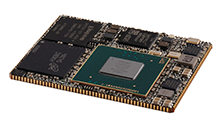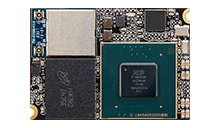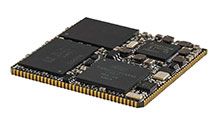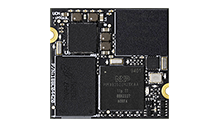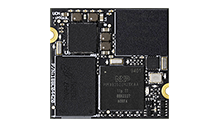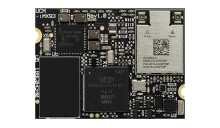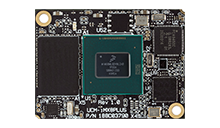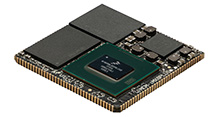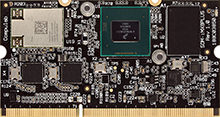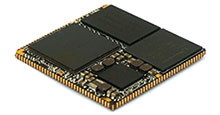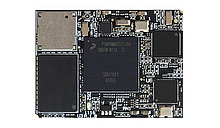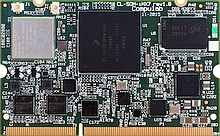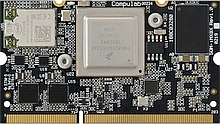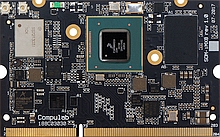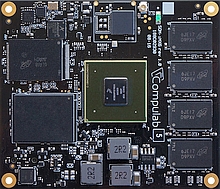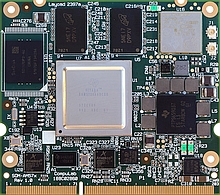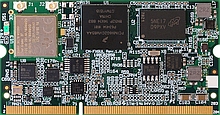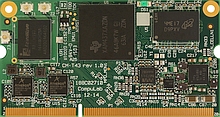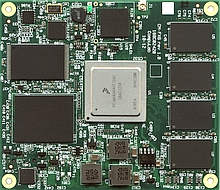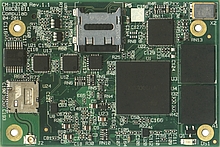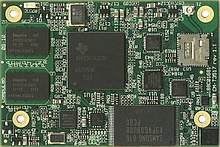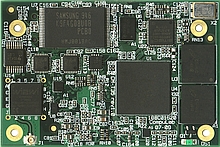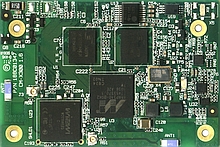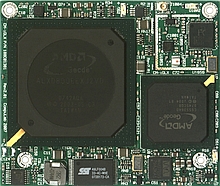System on Modules
A System on Module (SOM) / Computer on Module is a miniature circuit board that integrates core components of an embedded computer on a single module. System on Modules are designed to be plugged into carrier boards, which provide application specific peripheral devices and connectors.
System on Modules help product developers to accelerate time to market, optimize development cycle and reduce cost of ownership. Compulab SOM products are used by thousands of customers worldwide in medical devices, transportation, industrial automation, telecommunication, aerospace systems and countless other applications.
Advantages of Compulab System on Modules
- 15-Years Availability
- In-House Manufacturing
- Direct Engineer Support
- Linux and Yocto BSPs
- UCM pin2pin compatible SOMs
- SMT-level Configure-to-Order
-
- NXP i.MX95 @2.0GHz
- Up to 16GB LPDDR5, 128GB eMMC
- ARM Mali GPU, 4K VPU and AI/ML NPU
- 2x LVDS, MIPI-DSI, 2x MIPI-CSI
- 2x RGMII + 10GbE, 2x PCIe, USB3.0
- 5x CAN, 8x UART, 8x SPI, 75x GPIO
- SMD solder-down form-factor
- 34 x 42 x 3 mm
- NXP i.MX95 @2.0GHz
- Up to 16GB LPDDR5, 128GB eMMC
- ARM Mali GPU, 4K VPU and AI/ML NPU
- 2x LVDS, MIPI-DSI, 2x MIPI-CSI
- GbE + 10GbE, 2x PCIe, USB3.0
- Certified 802.11ax WiFi and BT 5.3
- 5x CAN, 8x UART, 8x SPI, 75x GPIO
- 28 x 40 mm, UCM pin2pin family
- NXP i.MX93 @1.7GHz
- Up to 2GB LPDDR4, 64GB eMMC
- AI/ML Neural Processing Unit
- LVDS, MIPI-DSI and parallel RGB
- 2x RGMII, 2x USB, 8x UART
- 8x SPI, 2x CAN-FD, 80x GPIO
- SMD solder-down form-factor
- 30 x 30 x 3 mm
- NXP i.MX91 @1.4GHz
- Up to 2GB LPDDR4, 64GB eMMC
- GbE, 2x RGMII, 2x USB
- 7x UART, 2x CAN-FD, 2x SDIO
- 7x SPI, 6x I2C, 65x GPIO
- 28 x 30 x 4 mm, UCM pin2pin family
- NXP i.MX93 @1.7GHz
- Up to 2GB LPDDR4, 64GB eMMC
- AI/ML Neural Processing Unit
- LVDS, MIPI-DSI and MIPI-CSI
- GbE, RGMII, 2x USB
- 7x UART, 2x CAN-FD, 2x SDIO
- 7x SPI, 6x I2C, 65x GPIO
- 28 x 30 x 4 mm, UCM pin2pin family
- NXP i.MX93 @1.7GHz
- Up to 2GB LPDDR4, 64GB eMMC
- AI/ML Neural Processing Unit
- LVDS, MIPI-DSI and MIPI-CSI
- GbE, 2x RGMII, 2x USB
- 7x UART, 2x CAN-FD, 79x GPIO
- Certified 802.11ac WiFi, BT 5.3
- 28 x 38 mm, UCM pin2pin family
- NXP i.MX8M Plus @1.8GHz
- Up to 8GB LPDDR4, 64GB eMMC
- AI/ML Neural Processing Unit
- 1080p VPU and GPU
- HDMI, LVDS, MIPI-DSI, 2x MIPI-CSI
- PCIe, GbE, 2x USB3.0
- 2x CAN, 4x UART, 75x GPIO
- 28 x 38 mm, UCM pin2pin family
- NXP i.MX8M Plus @1.8GHz
- Up to 8GB LPDDR4, 64GB eMMC
- AI/ML NPU, 1080p VPU and GPU
- HDMI, LVDS, MIPI-DSI, 2x MIPI-CSI
- PCIe, 2x RGMII, 2x USB3.0
- 2x CAN, 4x UART, 115x GPIO
- SMD solder-down form-factor
- 30 x 30 x 3 mm
- NXP i.MX8M Plus @1.8GHz
- Up to 8GB LPDDR4, 128GB eMMC
- AI/ML NPU, 1080p GPU and VPU
- HDMI, LVDS, MIPI-DSI, 2x MIPI-CSI
- 2x GbE / RGMII, PCIe, 2x USB3.0
- 2x CAN, 4x UART, 88x GPIO
- Certified 802.11ac WiFi, BT 5.0
- 36 x 68 x 5 mm
- NXP i.MX8M Mini @1.8GHz
- Up to 4GB LPDDR4, 64GB eMMC
- 1080p VPU and GPU
- MIPI-DSI and MIPI-CSI
- PCIe, RGMII, 2x USB
- 4x UART, 2x SDIO, 86x GPIO
- SMD solder-down form-factor
- 30 x 30 x 3 mm
- NXP i.MX8M Mini @1.8GHz
- Up to 4GB LPDDR4, 64GB eMMC
- 1080p VPU and GPU
- MIPI-DSI and MIPI-CSI
- PCIe, GbE, 2x USB
- 4x UART, SDIO, 85x GPIO
- WiFi 802.11ac and BT 4.2
- 28 x 38 mm, UCM pin2pin family
- NXP i.MX7 @1GHz
- Real-time Cortex-M4 MCU
- Up to 2GB DDR3, 32GB eMMC
- LVDS, MIPI-DSI, parallel RGB
- PCIe, 2x GbE, 5x USB, 2x SDIO
- 7x UART, 2x CAN, 124x GPIO
- WiFi 802.11a/b/g/n and BT 4.1
- 42 x 68 x 5 mm
-
-
Product MCM-iMX93 UCM-iMX95 UCM-iMX91L UCM-iMX93L UCM-iMX93 UCM-iMX8M-Plus CL-SOM-iMX8Plus MCM-iMX8M-Mini UCM-iMX8M-Mini SoC Family Form Factor Connection Type Size (mm) Introduced Longevity NXP i.MX93 SMD solder-down 140-pad soldered QFN 30 x 30 x 3 2024 until 2038 NXP i.MX95 UCM pin2pin 2x 100-pin mezzanine 28 x 40 x 5 2024 until 2039 NXP i.MX91 UCM pin2pin 2x 100-pin mezzanine 28 x 30 x 4 2024 until 2039 NXP i.MX93 UCM pin2pin 2x 100-pin mezzanine 28 x 30 x 4 2023 until 2038 NXP i.MX93 UCM pin2pin 2x 100-pin mezzanine 28 x 38 x 4 2023 until 2038 NXP i.MX8M Plus UCM pin2pin 2x 100-pin mezzanine 28 x 38 x 5 2021 until 2036 NXP i.MX8M Plus SODIMM 204-pin edge 36 x 68 x 5 2021 until 2036 NXP i.MX8M Mini SMD solder-down 140-pad soldered QFN 30 x 30 x 3 2020 until 2035 NXP i.MX8M Mini UCM pin2pin 2x 100-pin mezzanine 28 x 38 x 4 2019 until 2035 -
Product MCM-iMX93 UCM-iMX95 UCM-iMX91L UCM-iMX93L UCM-iMX93 UCM-iMX8M-Plus CL-SOM-iMX8Plus MCM-iMX8M-Mini UCM-iMX8M-Mini System-on-Chip CPU Cores Frequency Real-Time
Co-processorGPU AI/ML
Processing UnitNXP i.MX93 2x Cortex-A55 1.7GHz Cortex-M33 - up to 0.5 TOPS NXP i.MX95 6x Cortex-A55 2.0GHz Cortex-M7 ARM Mali GPU up to 2.0 TOPS NXP i.MX91 1x Cortex-A55 1.4GHz - - - NXP i.MX93 2x Cortex-A55 1.7GHz Cortex-M33 - up to 0.5 TOPS NXP i.MX93 2x Cortex-A55 1.7GHz Cortex-M33 - up to 0.5 TOPS NXP i.MX8M Plus 4x Cortex-A53 1.8GHz Cortex-M7 GC7000UL GPU up to 2.3 TOPS NXP i.MX8M Plus 4x Cortex-A53 1.8GHz Cortex-M7 GC7000UL GPU up to 2.3 TOPS NXP i.MX8M Mini 4x Cortex-A53 1.8GHz Cortex-M4 GC NanoUltra GPU - NXP i.MX8M Mini 4x Cortex-A53 1.8GHz Cortex-M4 GC NanoUltra GPU - -
Product MCM-iMX93 UCM-iMX95 UCM-iMX91L UCM-iMX93L UCM-iMX93 UCM-iMX8M-Plus CL-SOM-iMX8Plus MCM-iMX8M-Mini UCM-iMX8M-Mini RAM type RAM size RAM data
widthStorage type Storage size LPDDR4 512MB – 2GB 16-bit eMMC 8GB - 64GB LPDDR5 4GB – 16GB 32-bit eMMC 16GB - 128GB LPDDR4 512MB – 2GB 16-bit eMMC 8GB - 64GB LPDDR4 512MB – 2GB 16-bit eMMC 8GB - 64GB LPDDR4 512MB – 2GB 16-bit eMMC 8GB - 64GB LPDDR4 1GB – 8GB 32-bit eMMC 16GB - 64GB LPDDR4 1GB – 8GB 32-bit eMMC 16GB - 128GB LPDDR4 1GB – 4GB 32-bit eMMC 4GB - 64GB LPDDR4 1GB – 4GB 32-bit eMMC 4GB - 64GB -
Product MCM-iMX93 UCM-iMX95 UCM-iMX91L UCM-iMX93L UCM-iMX93 UCM-iMX8M-Plus CL-SOM-iMX8Plus MCM-iMX8M-Mini UCM-iMX8M-Mini Display
InterfacesMax
ResolutionVideo
DecodingCamera
InterfacesVideo
EncodingLVDS, MIPI-DSI, parallel RGB 1920 x 1080 - MIPI-CSI, 2 lanes - 2x LVDS, MIPI-DSI 4096 x 2160 4Kp60 2x MIPI-CSI, 4 lanes 4Kp60 - - - - - LVDS, MIPI-DSI 1920 x 1080 - MIPI-CSI, 2 lanes - LVDS, MIPI-DSI 1920 x 1080 - MIPI-CSI, 2 lanes - HDMI, LVDS, MIPI-DSI 1920 x 1080 1080p60 2x MIPI-CSI, 4 lanes 1080p60 HDMI, LVDS, MIPI-DSI 1920 x 1080 1080p60 2x MIPI-CSI, 4 lanes 1080p60 MIPI-DSI 1920 x 1080 1080p60 MIPI-CSI, 4 lanes 1080p60 MIPI-DSI 1920 x 1080 1080p60 MIPI-CSI, 4 lanes 1080p60 -
Product MCM-iMX93 UCM-iMX95 UCM-iMX91L UCM-iMX93L UCM-iMX93 UCM-iMX8M-Plus CL-SOM-iMX8Plus MCM-iMX8M-Mini UCM-iMX8M-Mini Ethernet WiFi BT USB 3.0 USB 2.0 PCIe UART CAN SDIO SPI I2C GPIO 2x RGMII - - - 2 - 8 2 2 8 6 80 1x GbE + 1x RGMII + 10 GbE 802.11ax 5.3 1 1 2 8 5 2 8 7 75 1x GbE + 1x RGMII - - - 2 - 7 2 2 7 6 65 1x GbE + 1x RGMII - - - 2 - 7 2 2 7 6 65 1x GbE + 1x RGMII 802.11ac 5.3 - 2 - 7 2 2 7 6 79 1x GbE + 1x RGMII - - 2 - 1 4 2 2 2 5 75 2x GbE / RGMII 802.11ac 5.3 2 - 1 4 2 2 3 6 90 1x RGMII - - - 2 1 4 - 2 3 3 86 1x GbE / RGMII 802.11ac 4.2 - 2 1 4 - 1 3 3 85 -
Product MCM-iMX93 UCM-iMX95 UCM-iMX91L UCM-iMX93L UCM-iMX93 UCM-iMX8M-Plus CL-SOM-iMX8Plus MCM-iMX8M-Mini UCM-iMX8M-Mini Linux Kernel Yocto Debian Android FreeRTOS 6.6 ✓ ✓ - ✓ 6.6 ✓ ✓ - ✓ 6.6 ✓ ✓ - ✓ 6.6 ✓ ✓ - ✓ 6.6 ✓ ✓ - ✓ 6.6 ✓ ✓ - ✓ 6.6 ✓ ✓ - ✓ 6.6 ✓ ✓ Android 10.0 ✓ 6.6 ✓ ✓ Android 10.0 ✓
-
-
- NXP i.MX8X @1.2GHz
- Up to 4GB LPDDR4, 64GB eMMC
- 4K VPU, Vivante GC7000Lite GPU
- 2x MIPI-DSI / dual-channel LVDS
- 2x GbE, PCIe, 4x USB
- 4x UART, 3x CAN-FD, 96x GPIO
- WiFi 802.11ac and BT 4.2
- 38 x 68 x 5 mm
- NXP i.MX8M @1.5GHz
- Up to 4GB LPDDR4, 64GB eMMC
- 4K VPU & Vivante GC7000Lite GPU
- HDMI, LVDS and MIPI-DSI
- PCIe, GbE, USB3.0
- 4x UART, SDIO, 60x GPIO
- WiFi 802.11ac and BT 4.2
- 42 x 68 x 5 mm
- NXP i.MX6 @1GHz
- Up to 4GB DDR3, 32GB eMMC
- 1080p with H.264, VC1, DivX
- 2D/3D Vivante GPU
- HDMI, LVDS, parallel RGB
- GbE , SATA, 5x USB, 5x UART
- PCIe, 3x SDIO, 2x CAN, 112x GPIO
- WiFi 802.11a/b/g/n/ac and BT 4.1
- Parallel camera and MIPI-CSI
- 75 x 65 x 6 mm
- TI AM5728 @1.5GHz
- Up to 4GB DDR3
- Up to 32GB eMMC / NAND
- PowerVR SGX544 and 1080p VPU
- C66x DSP and PRU-ICSS
- HDMI, LVDS, parallel RGB
- 2x PCIe, USB3.0, 3x USB2.0
- 2x GbE, SATA, 2x CAN
- 9x UART, 3x SDIO, 87x GPIO
- WiFi 802.11a/b/g/n and BT 4.1
- Analog and digital audio
- 60 x 68 x 5 mm
- NXP i.MX6UL @528MHz
- Up to 1GB DDR3, 32GB eMMC
- LCD ctrl., up to 1366 x 768
- Ethernet, 5x USB, 2x CAN
- 8x UART, SDIO, 78x GPIO
- WiFi 802.11a/b/g/n and BT 4.1
- 3x SPI, 3x I2C, 10x ADC
- 36 x 68 x 5 mm
- TI AM4379 @1GHz
- Up to 1GB DDR3, 32GB eMMC
- PowerVR SGX530 GPU
- LCD ctrl., up to 1400x1050
- 2x GbE, 3x USB, 2x CAN
- 6x UART, 3x SDIO, 133x GPIO
- WiFi 802.11ac and BT 4.0
- 36 x 68 x 5 mm
- NXP i.MX6 @1.2GHz
- Up to 4GB DDR3, 32GB SSD
- 1080p with H.264, VC1, DivX
- HDMI, LVDS, parallel RGB
- PCI Express Gen 2.0
- GbE, 5x USB, 5x UART
- 3x SDIO, 2x CAN, 112x GPIO
- WiFi 802.11b/g/n and Bluetooth
- Analog and digital audio
- 75 x 65 x 6 mm
- TI AM3354 @600MHz
- 2D/3D graphics acceleration
- Up to 512MB DDR3, 1GB NAND
- LCD ctrl., up to 1366x768
- GbE, 4x USB, 5x UART
- CAN, GPIO, SDIO/MMC
- WiFi and Bluetooth
- 68 x 30 x 5 mm
- TI DM3730 @1000MHz
- H.264, MPEG4 & WMV9 codecs
- 2D/3D hardware acceleration
- Up-to 256MB DDR, 8GB storage
- TFT & STN LCD, PAL/NTSC TV
- 3x USB, 3x UART
- GPIO, SDIO/MMC
- WiFi & Bluetooth
- 100Mb Ethernet
- 66 x 44 x 7 mm
- TI AM3517 @600MHz
- 2D/3D hardware acceleration
- Up-to 256MB DDR2, 8GB flash
- TFT LCD, PAL/NTSC TV
- GPIO, SDIO/MMC
- 5x USB, 4x COM, CAN bus
- WiFi & BT interface
- Audio speaker & mic
- 100Mb Ethernet
- 66 x 44 x 7 mm
- TI OMAP3530 @720MHz
- H.264, MPEG4 & WMV9 codecs
- 2D/3D hardware acceleration
- Up-to 256MB mDDR, 512MB NAND
- TFT LCD, PAL/NTSC TV
- 3x USB, 3x COM
- GPIO, SDIO/MMC
- WiFi interface
- 100Mb Ethernet
- 66 x 44 x 7 mm
- Marvell PXA300 @624MHz
- Up-to 128MB DDR, 512MB NAND
- Audio speaker & mic
- Battery management
- AC97, GPIO, SDIO/MMC
- 3x USB, 3x COM
- TFT & STN LCD
- WiFi and Bluetooth
- 100Mb Ethernet
- 66 x 44 x 7 mm
- Geode LX800 @500MHz
- Up-to 512MB DDR, 512MB flash
- SXGA for CRT & LCD
- Hard disk
- PCI, GPIO, LPC, AC97
- 2x COM, Audio I/O
- 100Mb Ethernet
- Touchscreen
- 4x USB
- 68 x 58 x 8 mm
Benefits of using System-on-Module
Accelerate time to market
Minimize risk and reduce development time by using a System on Module as a proven and validated off-the-shelf solution.
Optimize development costs
Avoid the costs associated with designing and manufacturing complex computer hardware and leverage economy of scale.
Offload complexity
Allow your developers to focus on your core application hardware and software and unique product features.
Ensure long-term availability
Benefit from reliable supply and support throughout the lifecycle of your product with guaranteed 15-years SOM availability.
System-on-Module applications in industry
SOMs are a perfect fit for many different environments. In the medical field, SOMs power sophisticated diagnostic equipment and portable medical devices, enabling faster and more accurate healthcare solutions. Building automation systems leverage SOMs to control lighting, HVAC and security, enhancing energy efficiency and occupant comfort.
Precision measurement and laboratory devices rely on SOMs for their computational power and data acquisition capabilities, ensuring accurate and reliable results. System on Modules are also being used in industrial control systems, where plants utilize SOMs to monitor and control complex processes, increasing efficiency and productivity.
For additional information refer to System on Module Applications page.
Choosing the right System on Module
When you select a System-on-Module to integrate into your design, it becomes a critical component that will affect not just your product development, but also its manufacturing throughout the entire lifecycle.
There are many important factors to consider such as connectivity features, form-factor, software support, power consumption and vendor reliability.
Learn more in our comprehensive SOM Selection Guide.
